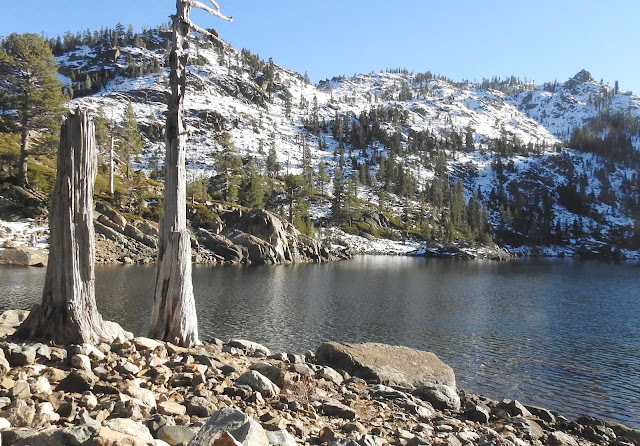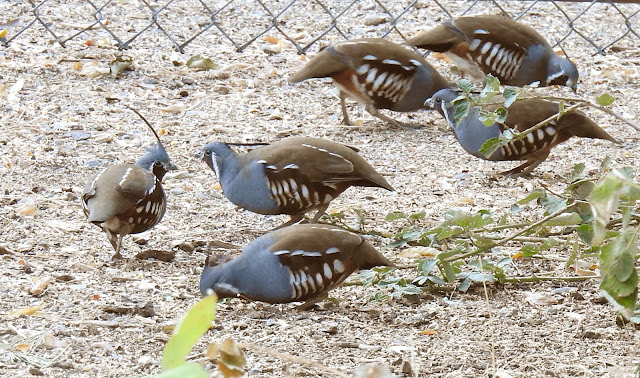Belted Kingfisher (female) - Megaceryle alcyon
There are three local ponds that I visit regularly during the winter and spring. The closest ones are left over from the hydraulic mining days, a hundred+ years ago! I mainly observe them from the top of a bluff, but occasionally hike down to the pond level. Over the course of this past year some interesting waterfowl (and a River Otter!) have visited these ponds. Right now a few diving ducks are feeding there!
There is also a beautiful resident Kingfisher that presides over these ponds. Unlike most birds, the female Belted Kingfisher is more colorful than the male. The male does not have the rust-colored band across its chest, nor patches underneath its wings. Kingfishers catch small fish, crayfish, and tadpoles by plunge-diving from perches, into shallow or surface water. Most of their dives are less than 24" deep into the water. After they catch their prey, they bring it back to a perch and pound it against a branch to stun it! Whatever they cannot digest, such as fish bones etc, is regurgitated in pellets!
The steep hydraulicked banks on the south side of the pond are perfect nest sites for Kingfishers. Belted Kingfishers are solitary except during the breeding season. They are monogamous and usually only have 1 brood of 5-7 chicks. The nests are made in bare earthen banks by both the male and female. The male does most of the work. It will take the pair up to 3 weeks to excavate the 3'-6' long, horizontal, subterranean tunnel, that ends in an unlined nesting chamber!!! The opening to the tunnel ranges from 3"-5". I've never seen young Kingfishers at this pond, but maybe this year I will!
Joubert's Diggins
Last week I featured the dabbling ducks at Gray Lodge. The water there is only a few feet in depth, and that's why we didn't see any diving ducks. The ponds I visit are a LOT deeper, and attract diving ducks. Diving Ducks don't have lamellae like dabbling ducks, but some species have serrated bills that help them catch slippery fish. The following information on diving ducks is from the website ducks.org/conservation/waterfowl-research-science/diving-ducks-into-the-deep. I find it fascinating!
"The body of a diving duck is much more compact and fusiform (wider in the middle and tapering toward the end) than that of a dabbler. Divers' wings are also more compact, which allows them to be compressed tightly against the body for greater diving efficiency. In addition, divers' legs are set much farther back on their body, and their feet are much larger and have a lobed hind toe. These adaptations help propel the birds while they are underwater.
In general, most birds are lighter than water. But diving ducks typically have higher body densities than other waterfowl. Just before they dive, the birds compress their feathers against their body, squeezing out air, which further reduces buoyancy. Next, with a single thrust of their powerful legs and feet, diving ducks arch their bodies upward and dive headlong, quickly disappearing beneath the water's surface."
Hooded Merganser (male-female) - Lophodytes cucullatus
"Once underwater, the birds use their feet and wings to propel them downward in search of food. They steer during descent largely by shifting their head and tail positions. Once near the bottom, diving ducks use their feet to maintain a hovering position while they forage for aquatic insects, small mollusks, seeds, vegetation, roots, tubers, and other food. Diving ducks will actively forage at all times of day or night.
Not surprisingly, the duration of each dive increases with foraging depth. A typical dive takes 10-30 seconds, but diving ducks may remain underwater for a minute or more."
Bufflehead (female-male) - Bucephala albeola
"As you might expect, diving ducks carry large volumes of air with them when they dive. Like other specialized diving birds, diving ducks also have an unusually high tolerance for asphyxia, or lack of air. In fact, diving ducks reduce their oxygen consumption while they are underwater. During a dive, available oxygen is rationed sparingly to sensitive tissues in the central nervous system and sensory organs. In addition, the heart rate is reduced, and blood flow to most other organs and skeletal muscles is curtailed. At these times, organs and tissues rely on anaerobic (oxygen-free) metabolism. This "diving reflex" is triggered when water touches special receptors in the birds' nares (nostrils)."
Bufflehead (male-female) - Bucephala albeola
"When the dive is complete, diving ducks simply relax their muscles, stop paddling, and ascend to the surface like a cork. Diving ducks that feed on submersed aquatic vegetation or sedentary invertebrates like clams return to the surface in almost the same place. But birds feeding on mobile prey like amphipods or fish may surface more than 50 feet from the initial dive location. Following each dive, the birds take a short rest break of 10-30 seconds before diving again."
Upper Sardine Lake 12/8/20
This week we drove up to the Lakes Basin to see what the snow was like. It was patchy and varied in depth from 0"-12" depending on the location. The old snow on the the road to Sardine Lake was REALLY icy and made walking super treacherous! We walked to Upper Sardine Lake, as the trail is in a really sunny, south-facing slope and there wasn't any snow on it. The lake wasn't frozen at all!
Sierra Buttes from the Salmon Lake Road - 12/8/20
We also walked to Salmon Lake on the road, which had 12" of packed snow on it and wasn't slippery. Salmon Lake wasn't frozen either, but it had a thin layer of ice along the edges. There were lots of animal tracks in the snow. The only mammal we saw was a Lodgepole Chipmunk eating a nut of some kind!
Surprisingly, we saw a pair of Common Goldeneyes on the lake and a nearby pair of Ravens! The Ravens might have been the pair I watched "allopreen" each other several years ago near Salmon Lake. It was a beautiful sparkly snow, blue-sky day to be back in the Lakes Basin! Winter weather is in the forecast for this weekend. I hope it brings a lot more snow!
Common Ravens - 11/26/18
(Check out my December 1, 2018 blog for more photos
and information on this Raven couple.)
A Thanksgiving Feast! - 11/24/20
Project FeederWatch Update
The number of birds has really dropped at my feeding station! The Pine Siskins, Golden-crowned Sparrows, and White-crowned Sparrows aren't around anymore. However the Dark-eyed Juncos have arrived, and the Steller's Jays have increased in number. I still regularly see a few Spotted Towhees and Fox Sparrows. On
Thanksgiving I put out a bunch of fruit, chopped nuts, grain, and seeds, just for fun! It was all TOTALLY gone by the next morning!
Thanksgiving I put out a bunch of fruit, chopped nuts, grain, and seeds, just for fun! It was all TOTALLY gone by the next morning!
Mountain Quail - Oreortyx pictus
In the late afternoon, before it gets dark, I've often been delighted to see a small covey of Mountain Quail feeding! They are such beautiful birds! They are the largest North American Quail, measuring 11" in height, with a wingspan of 16", and a weight of 8 oz. They are different from other Quail in that they are sexually monomorphic (the male and female look alike), have a long-distance seasonal migration (20+ miles) on foot in spring and fall, and eat a large variety of plants and seeds. They eat flowers, leaves, seeds, acorns, mushrooms, bulbs, and some insects. In the fall and winter they stay together in small coveys of family related groups, while foraging and roosting.
Mountain Quail - Oreortyx pictus
Usually I see 9 or 10 quail in this covey. They are hard to photograph, as they take off as soon as I get anywhere near them! A good trait when avoiding predators, such as Sharp-shinned Hawks!
California Quail - Callipepla californica
To my surprise, there are two California Quail in our neighborhood! I've never seen them here before! Usually in fall and winter their coveys range in size from 25-73 individuals! There may be more here but I've only seen these two males. They are the state bird of California! Their latin name Callipepla means "beautifully dressed"! In the world, they are only found on the west cost of North America from British Columbia through Baja California! The foothills, central valley, and coastal areas of California are where they primarily live year round. They can also live in the Mohave desert! They don't usually live up at our elevation of approximately 2,500'. They do not seasonally migrate like the Mountain Quail. They are sexually dimorphic (male and female do not look alike). They eat fruit, seeds, acorns, leaves, flowers, berries, grain, catkins, plant galls, insects and even sporangia!
California Quail - Callipepla californica
They are so beautifully feathered! I hope I see a big covey of them!
I'll keep you posted!
Sporophytes on Dendroalsia Moss
Looking for Tardigrades!
I did look for Tardigrades in some moss, and I think I saw one! I used a
dissecting microscope and it was great! I found a wonderful natural history website at https://infinitespider.com/?s=tardigrade, that had great information on Tardigrades (Water Bears/Moss Piglets) and how to find them. As instructed, I took a small 2-3" piece of damp moss off a rock, and set it in a bowl with 1/4" of water in it. I let it sit for 24 hours. Then I gently squeezed some of the water off. Then I squeezed the remaining water into a shallow dish, and placed it under the microscope. At first the only movement I saw were transparent nematodes swirling around in the water. Then in a little while I saw a tiny, transparent critter, that was slightly jelly-bean shaped scooting around in the water! The magnification I have didn't seem to be enough to really get close enough to identify it! But MAYBE I saw one! I'm going to try again, it was so fun! Try it yourself if you have a microscope handy!
We still need stormy, wet Weather!
Even though we got 5.13" of rain in November, we still need a LOT more. I am once again sending out a "Call for Art", this time in celebration of winter weather. My intention is to focus on the need for rain or snow, and through collective positive energy invoke them to fall. It is just a wish, a thought, and a hope. If you would like to submit some art, or writing, or a photo please check out my blog at dampearthart.blogspot.com. I will be posting new art weekly.
You can view what was submitted last year at dampearth.blogspot.com.
Check it out and pray for rain!
Are there any birds on the river?
What's happening in the Foothills?
Does Lichen have the same relationship with rain/water that Moss has?
Check back next week for the answers to these questions and more!
Unfortunately you can no longer sign up to get my blog emailed to you.
Something changed at Blogspot.com. Oh well... However, my blog looks better if you just go to northyubanaturalist.blogspot.com, rather than get the emailed version. I suggest that you just bookmark my blog and visit it every Sunday afternoon!
Your questions and comments are greatly appreciated!
Please email me at northyubanaturalist@gmail.com.

















No comments:
Post a Comment